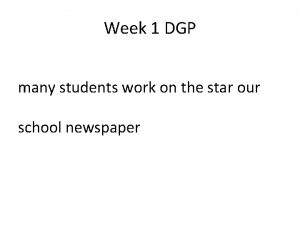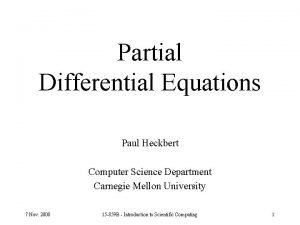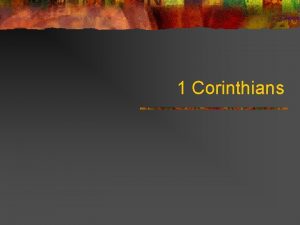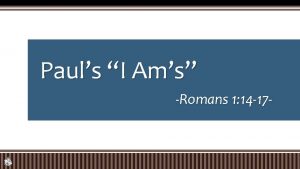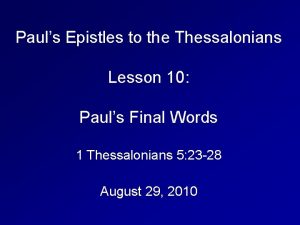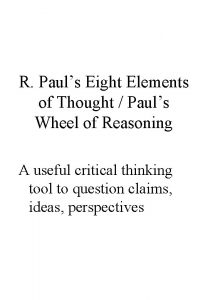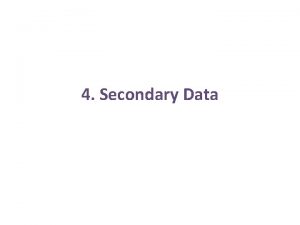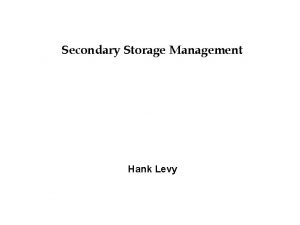SCHOOL ST PAULS OMONAYO SECONDARY SCHOOL TEACHERS MR














- Slides: 14

SCHOOL ST PAUL’S OMONAYO SECONDARY SCHOOL TEACHERS MR. OCHENGO COUNTY NYAMIRA CLASS FORM 3 SUBJECT CHEMISTRY TOPIC THE MOLE RATIONALE What knowledge is to be taught? Determing the concentration of a given substance Why should students learn this knowledge? So that the learners to understand how different substances are standardized How to teach lesson? Student centred and interactive - involving the student fully after a demonstration and giving out the gu Pivotal questioning technique Where is the topic in syllabus? Third topic in form 3 syllabus OBJECTIVES By the end of the lesson, the learner should be able to: 1. Manipulate the apparatus used in titration 2. Fill titration table 3. Use the data recorded to work out the concentration of the substance in question PREREQUISIT SKILLS AND KNOWLEDGE Since this sub topic is in the middle of the topic Students have acquired a lot of knowledge from form 1 when they were studying the apparatus used in measuring volume They can relate with real life and can process They can analyse related information. 21 st Century Skills RESOURCES – ICT Laptop, desktops, projector, flash animation, Java flash player, images, internet – you tube Open education resources KNEC syllabus Kenya secondary school syllabus online at: http: //www. elimu. net/Secondary/Kenya/KCSE_Student/Choice%20 of%20 KCSE%20 subjects. htm RESOURCES – NON ICT Creativity and critical thinking – the Worksheet is designed in such a manner some activities, questions are open ended Collaboration and communication when students interact with their peers during the activities and the information they shar common School Library repository (As a Teacher I would make this materials accessible for the general school community in th computer library) Klb Form three science textbook jgthungu@gmail. com Worksheets, BB, chalk, note books , flip charts 1

Practically volumetric analysis involves titration. Titration generally involves filling a burette with known /unknown concentration of a solution then adding the solution to unknown/known concentration of another solution in a conical flask until there is complete reaction. If solutions used are both colourless, an indicator is added to the conical flask. When the reaction is over, a slight excess of burette contents change the colour of the indicator. This is called the end point. The titration process involves determination of titre. The titre is the volume of burette contents/reading before and after the end point. Burette contents/reading before titration is usually called the Initial burette reading. Burette contents/reading after titration is usually called Final burette reading. The titre value is thus a sum of the Final less Initial burette readings. To reduce errors, titration process should be repeated at least once more. The results of titration are recorded in a titration table jgthungu@gmail. com 2

Set up of Titration apparatus 0. 0 mark Suck using pipette filler/mouth Solution B 25. 0 cm 3 calibration mark 50. 0 mark Solution A/ Whitejgthungu@gmail. com surface/tile 3

Sample titration table Titration number 1 2 3 Final burette reading (cm 3) 20. 0 Initial burette reading (cm 3) 0. 0 Volume of solution used(cm 3) 20. 0 As evidence of a titration actually done, examining body requires the candidate to record their burette readings before and after the titration. For KCSE candidates in Kenya burette readings must be recorded in a titration table in the format provided by the Kenya National Examination Council. As evidence of all titration actually done, candidates should record their burette readings before and after the titration to 4 complete the titration tablejgthungu@gmail. com in the format provided.

Calculate the average volume of solution used 24. 0 + 24. 0 = 24. 0 cm 3 3 As evidence of understanding the degree of accuracy of burettes , all readings must be recorded to a decimal point. As evidence of accuracy in carrying the out the titration , candidates value should be within 0. 2 of the school value. The school value is the teachers readings presented to the examining body/council based on the concentrations of the solutions s/he presented to her/his candidates. Bonus mark is awarded for averaged reading within 0. 1 school value as Final accuracy. Calculations involved after the titration require candidates jgthungu@gmail. com thorough practice mastery on the: 5

(i)relationship among the mole, molar mass, mole ratios, concentration, molarity. (ii) mathematical application of 1 st principles. Very useful information which candidates forget appears usually in the beginning of the paper as: “You are provided with…” All calculation must be to the 4 th decimal point unless they divide fully to a lesser decimal point. Candidates are expected to use a non programmable scientific calculators Sample Titration Practice 1(Simple Titration) You are provided with: 0. 1 M sodium hydroxide solution A jgthungu@gmail. com Hydrochloric acid solution B 6

You are required to determine the concentration of solution B in moles per litre. Procedure Fill the burette with solution B. Pipette 25. 0 cm 3 of solution A into a conical flask. Titrate solution A with solution B using phenolphthalein indicator to complete the titration table 1 Sample results Titration number 1 2 3 Final burette reading (cm 3) 20. 0 Initial burette reading (cm 3) 0. 0 Volume of solution B used(cm 3) 20. 0 jgthungu@gmail. com 7

Sample worked questions Calculate the average volume of solution B used Average titre = Titre 1+Titre 2+Titre 3=>( 20. 0 +20. 0 ) = 20. 0 cm 3 3 3 2. How many moles of: (i)solution A were present in 25 cm 3 solution. Moles of solution A = Molarity x volume 1000 => 0. 1 x 25 = 2. 5 x 10 -3 moles 1000 (ii)solution B were present in the average volume. Chemical equation: Na. OH(aq) + HCl(aq) -> Na. Cl(aq) + H 2 O(l) Mole ratio 1: 1 => Moles of A = Moles of B = 2. 5 x 10 -3 moles (iii) solution B in moles per litre. Moles of B per litre = moles x 1000 = 2. 5 x 10 -3 x 1000 = 0. 1 M jgthungu@gmail. com 8 Volume 20

Sample Titration Practice 2 (Redox Titration) You are provided with: Acidified Potassium manganate(VII) solution A 0. 1 M of an iron (II)salt solution B 8. 5 g of ammonium iron(II)sulphate(VI) crystals (NH 4)2 SO 4 Fe. SO 4. x. H 2 O solid C You are required to (i)standardize acidified potassium manganaate(VII) (ii)determine the value of x in the formular (NH 4)2 SO 4 Fe. SO 4. x. H 2 O. Procedure 1 Fill the burette with solution A. Pipette 25. 0 cm 3 of solution B into a conical flask. Titrate solution A with solution B until a pink colour just appears. Record your results to complete table 1. jgthungu@gmail. com 9

Table 1: Sample results Titration number Final burette reading (cm 3) Initial burette reading (cm 3) Volume of solution A used(cm 3) 1 20. 0 2 20. 0 3 20. 0 Sample worked questions 1. Calculate the average volume of solution A used Average titre = Titre 1 + Titre 2 +Titre 3 => 3 ( 20. 0 +20. 0 ) = 20. 0 cm 3 3 2. How many moles of: (i)solution B were present in 25 cm 3 solution. Moles of solution A = Molarity x volume 1000 = 0. 1 x 25 = 2. 5 x 10 -3 moles jgthungu@gmail. com 1000 10

(iii) solution B in 250 cm 3. Moles of B per litre = moles x 250 = 1. 0 x 10 -4 x 250 Volume 25 = 1. 0 x 10 -3 moles 3. Calculate the molar mass of solid C and hence the value of x in the chemical formula (NH 4)2 SO 4 Fe. SO 4. x. H 2 O. (N=14. 0, S=32. 0, Fe=56. 0, H=1. 0 O=16. 0) Molar mass = mass perlitre = 8. 5 = 8500 Moles per litre 1. 0 x 10 -3 moles NH 4)2 SO 4 Fe. SO 4. x. H 2 O = 8500 284 + 18 x =8500 - 284 = 8216 =18 x 18 18 = 454. 4444 x =454(whole number)11 jgthungu@gmail. com

Sample Titration Practice 3 (Redox double titration) You are provided with: Acidified Potassium manganate(VII) solution A 0. 1 M of an iron (II)salt solution B 8. 5 g of ammonium iron(II)sulphate(VI) crystals (NH 4)2 SO 4 Fe. SO 4. x. H 2 O solid C You are required to (i)standardize acidified potassium manganate(VII) (ii)determine the value of x in the formula (NH 4)2 SO 4 Fe. SO 4. x. H 2 O. Procedure 1 Fill the burette with solution A. Pipette 25. 0 cm 3 of solution B into a conical flask. Titrate solution A with solution B until a pink colour just appears. Record your results to complete table 1. jgthungu@gmail. com 12

The End Julius G. Thungu 0711 354 885 Dedicated to you, …the CHEMISTRY Candidate. jgthungu@gmail. com 13

2012 -2013 KNEC SYLLABUS THE MOLE Comprehensive tutorial notes Julius G Thungu jgthungu@gmail. com
 St paul's church wibsey
St paul's church wibsey Meridian secondary school principal
Meridian secondary school principal Duncanrig secondary school
Duncanrig secondary school Kim kroll teachers pay teachers
Kim kroll teachers pay teachers Alfonso my mother's cousin
Alfonso my mother's cousin Nyandoche high school
Nyandoche high school Differential equations in computer science
Differential equations in computer science Pauls first missionary journey map
Pauls first missionary journey map Paul second missionary journey map
Paul second missionary journey map Eportal st pauls monasterevin
Eportal st pauls monasterevin Paulu koelju darbi
Paulu koelju darbi St pauls cathedral
St pauls cathedral St paul's missionary journeys
St paul's missionary journeys St paul's monasterevin
St paul's monasterevin Ousedale uniform
Ousedale uniform




